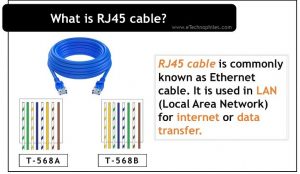Last updated on April 5th, 2024 at 01:13 pm
CAT cables, commonly known as RJ45 cables are used in LAN (Local Area Network) for internet or data transfer. They are available in various categories, like CAT5, CAT6, etc. And also has different types, like Straight cable (Patch cable), and Crossover cable.
In this article, we will discuss RJ45 cable in detail. We will also see different types of Ethernet cables and look at the speeds supported by different cable standards.
Table of Contents
Basics of RJ45 cable (Ethernet cable)
RJ45 cable consists of 8 wires of different colors that connect to a connector head. One end of the cable connects to the port on your laptop, while the other end connects to a router or modem to transfer the signals.

This standard is known as 8P8C (8-position 8-contact). The 8 cables are used as 4 pairs. This set of cables is shielded together as twisted pairs, which are known as twisted pair cables.
Note: The Ethernet require only two pairs of wire, i.e., Orange and Green for internet connection. The other two pairs, i.e., Blue and Brown are used as ISDN or phone connections.
It enables multiple connections with a single connector due to which RJ45 was initially known as modular connectors. The connector comes with an orientation tab that helps in proper wiring.
Types of cables used in RJ45 connectors
RJ45 connector uses twisted-pair cables. These twisted pair cables are available in Unshielded Twisted Pair and Shielded Twisted Pair.
Unshielded twisted pair (UTP)
- It consists of 4 pairs of color-coded wires that are twisted around each other. This is done to prevent electromagnetic interference and distortion of the signal.
- It is used in home and office networks.
Shielded twisted pair (STP)
- It is similar to a shielded twisted pair cable, but it has an extra layer of protection against electromagnetic interference.
- It is used for industrial purposes.
Types of twisted-pair cable based on wiring standards
Ethernet cable can be wired using two different wiring standards, i.e., 568A and 568B. The difference between these two standards lies in the order, in which pairs are arranged inside the cable. Based on these standards, there are two types of twisted pair cable:
Straight cable(Patch)
When the two ends of the ethernet cable are connected using the same standard (either 568A or 568B), it is called a Straight or Patch cable. It is generally used to connect two dissimilar devices together. For example a laptop to a modem.
RJ-45 Straight cable pinout

As visible in the figure above, both connectors at the ends of the cable have the same standard (here shown T568-B).
Crossover cable
When the two ends of the ethernet cable are connected using opposite standards (one end 568A and the other end 568B), it is called a Crossover cable. It is generally used to connect two similar devices together. For example a laptop to another laptop.
RJ-45 crossover cable pinout

As visible in the figure above, both connectors at the ends of the cable have different standards. One side of the cable is connected to the T568-B standard, while the other is connected to the T568-A standard.
What are the different categories of twisted pair cables?
The five main categories used in twisted-pair are CAT3, CAT5, CAT6, CAT7, and CAT8. Out of these, CAT5 and CAT6 wires are commonly used with RJ45 connectors. The difference in the categories is the maximum speed they can handle without any interference. The table below gives the maximum speed provided by each category.
| Category | Maximum Speed |
| CATEGORY 3 (CAT3) | 10 Mbps |
| CATEGORY 5 (CAT5) | 100 Mbps |
| CATEGORY 5e (CAT5e) | 1 Gbps (Enhanced) |
| CATEGORY 6 (CAT6) | 1 Gbps (10 Gbps, if used with cable of length less than 100meters) |
| CATEGORY 6e (CAT6e) | 10 Gbps (Augmented) |
| CATEGORY 7 (CAT7) | 10 Gbps (Added shielding to wires) |
| CATEGORY 8 (CAT8) | 40 Gbps (Distance up to 30 meters) |
Applications of RJ45 cables
RJ45 cables are commonly used in Ethernet connections. Yet, they are useful for other applications also. For example:
- Automation systems
- Process control systems
- Fabrication and assembly of Industrial robotic arms
- Measurement systems
- Quality Control
- Voice Over Internet Protocol (VOIP) Devices
- Internet of Things (IoT) Devices
FAQs
What are TX- and TX+?
TX- refers to transmit negative, and TX+ refers to transmit positive. They are used in Ethernet connections for transmitting data over twisted pair cables. TX+ carries the positive polarity of the signal, while TX- carries the negative polarity.
Which wires are used in RJ45?
The RJ45 employs twisted-pair cables, which come in two variants: Unshielded Twisted Pair (UTP) and Shielded Twisted Pair (STP).
Are RJ45 and CAT6 the same?
No, RJ45 and CAT6 are not the same. The RJ45 is a connector, while CAT6 (CATEGORY 6) is a model of twisted-pair cables. But, CAT cables are commonly referred to as RJ45 cables or Ethernet cables.

The pin-out drawings are both labeled as RJ-45 Straight Cable Pinout. I got ot pretty quick, but some might get confused, The second diagram should be headed with RJ-45 Crossover Cable Pinout.
Hi Ken,
Thank you for bringing this to our attention.
The mistake has been rectified.